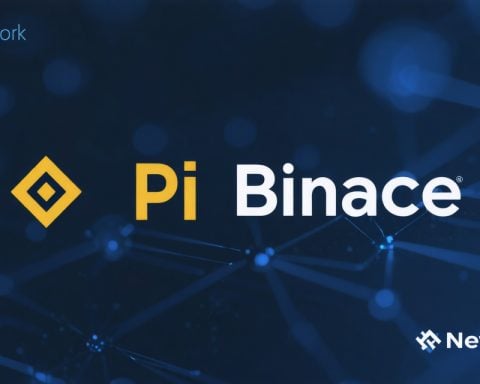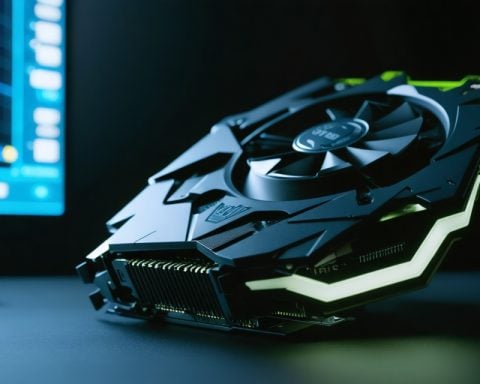- Nvidia anticipates a significant fourth-quarter report, with expected earnings per share growth of 63% and a 73% rise in revenue.
- The dominance of Nvidia’s Blackwell AI chips powers global data centers for tech giants like Amazon, Google, Meta, and Microsoft.
- Rivalry intensifies with competitors like DeepSeek offering more efficient and cost-effective AI models, challenging Nvidia’s market position.
- Geopolitical concerns, including potential tariffs and export restrictions, threaten Nvidia’s partnerships, especially in China.
- Nvidia upholds a strategy of high-end innovation, betting on advanced systems to maintain its leadership amidst growing competition.
- The company exemplifies how relentless innovation can help navigate an evolving tech landscape and stay ahead of market shifts.
Nvidia stands at a thrilling crossroads as investors eagerly await its fourth-quarter earnings report. The digital titan that towers over the AI chip landscape is expected to shine with soaring figures. Analysts have set the stage for dramatic growth: a stunning 63% leap in earnings per share and an eye-popping 73% surge in revenue, a stark spotlight for a company that is used to shattering ceilings.
With its Blackwell line of chips at the forefront, Nvidia remains an indomitable force, feeding the AI ambitions of titans like Amazon, Google, Meta, and Microsoft. Their burgeoning data centers hungrily devour Nvidia’s invaluable processing power, evidence of its unchallenged supremacy within Silicon Valley.
But all is not serene beneath the surface. New winds of competition swirl, mainly in the guise of emerging rivals like DeepSeek. By specializing in efficient AI models, they could lure clients towards more affordable alternatives, challenging Nvidia’s high-end stranglehold. Adding tension to the mix are geopolitical tremors—the looming specter of tariffs and export restrictions that could jeopardize its profitable partnerships with Chinese markets.
Yet, Nvidia’s response champions the age-old dictum: more is more. High-powered chips yield better results, and despite emerging low-cost challengers, Nvidia bets on its cutting-edge systems to clinch the deal.
In a tech world stretching its horizons, Nvidia continues to parry threats with finesse, keeping the industry on edge, eager to see if the giant will continue its ascent. Herein lies the power of relentless innovation—holding fast against the ticking clock of change.
The Future Unveiled: How Nvidia Is Leading the AI Chip Revolution
How-To Steps & Life Hacks
Optimizing AI Performance with Nvidia Chips
1. Identify AI Model Requirements: Before integrating Nvidia chips, understand the computational demands of your AI models. Determine the memory, speed, and power requirements to ensure compatibility.
2. Select the Right Nvidia Chip: For high-end applications, consider the latest Blackwell series. For more cost-effective solutions, explore earlier models that still offer excellent performance.
3. Installation and Setup: Incorporate Nvidia’s CUDA toolkit to facilitate seamless integration with existing AI frameworks. Leverage AI-specific libraries, like cuDNN, to maximize processing efficiency.
4. Regular Software Updates: Keep drivers and related software up-to-date to take advantage of performance improvements and security patches. Nvidia provides regular updates through its official platform.
Real-World Use Cases
Nvidia’s chips are driving some of the most advanced tech innovations:
– Autonomous Vehicles: Companies like Tesla utilize Nvidia GPUs to process massive amounts of sensor data in real-time, enabling safer autonomous driving.
– Healthcare Imaging: Nvidia chips power AI in diagnostic imaging, improving accuracy and speed in identifying conditions such as tumors or fractures.
– Gaming and Entertainment: The gaming industry heavily relies on Nvidia’s graphics cards for rendering high-quality visuals and supporting real-time ray tracing.
Market Forecasts & Industry Trends
Analysts predict that the global AI chip market will exceed $200 billion by 2030, with Nvidia maintaining a significant share due to its continuous innovation and strategic partnerships with major tech firms like Amazon and Google.
Reviews & Comparisons
Nvidia’s Blackwell series is often compared to AMD’s MI-Series accelerators and Intel’s Habana processors:
– Performance: Nvidia’s chips consistently outperform competitors in speed and power efficiency tests.
– Price: Nvidia GPUs tend to be more expensive, but they justify the cost through superior performance and support.
Controversies & Limitations
– Geopolitical Risks: Export restrictions and tariffs could affect Nvidia’s revenue from Chinese markets.
– Competition: Emerging competitors like DeepSeek specialize in efficient, low-cost AI models that could entice budget-conscious clients away from Nvidia.
Features, Specs & Pricing
– Blackwell Series: Boasting advanced architecture, enhanced AI model processing, and power efficiency.
– Pricing: Premium pricing reflects cutting-edge technology, often ranging from several thousand to tens of thousands based on specifications and configurations.
Security & Sustainability
Nvidia continually enhances the security features of its chips, integrating robust protection mechanisms against cyber threats. On the sustainability front, Nvidia focuses on developing energy-efficient technologies that reduce carbon footprints in data centers.
Insights & Predictions
Nvidia is likely to continue expanding its dominance in the AI chip market through strategic acquisitions, partnerships, and relentless R&D investments. Industry experts foresee Nvidia exploring quantum computing in the next decade, potentially revolutionizing technology further.
Pros & Cons Overview
Pros:
– Leading edge in AI chip performance.
– Extensive ecosystem and support for developers.
Cons:
– Higher costs compared to competitors.
– Vulnerable to geopolitical influences.
Actionable Recommendations
– For Developers: Leverage Nvidia’s comprehensive documentation and developer resources to maximize the performance and capabilities of your AI projects.
– For Businesses: Consider future-proofing your enterprise with Nvidia’s latest technology to stay ahead of competition in AI and data processing advancements.
– For Investors: Monitor Nvidia’s earnings and market trends to make informed decisions, keeping an eye on emerging competitors and geopolitical factors.
For more information, visit nvidia.com.



















